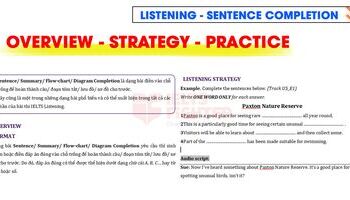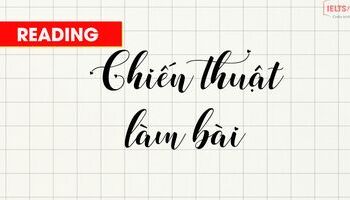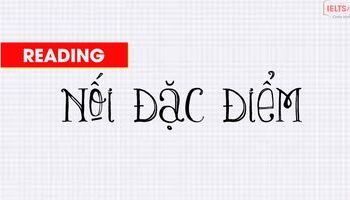Sentence/ Summary/ Flow-chart/ Diagram Completion là dạng bài điền vào chỗ trống để hoàn thành câu/ đoạn tóm tắt/ lưu đồ/ sơ đồ cho trước.
Đây cũng là một trong những dạng bài phổ biến và có thể xuất hiện trong tất cả các phần của bài thi IELTS Listening.
Format dạng bài
Dạng bài Sentence/ Summary/ Flow-chart/ Diagram Completion yêu cầu thí sinh chọn hoặc điền đáp án đúng vào chỗ trống để hoàn thành câu/ đoạn tóm tắt/ lưu đồ/ sơ đồ cho trước. Do đó, đáp án đúng có thể được thể hiện dưới dạng chữ cái A, B, C… hay từ và/ hoặc số.
Cùng xem video để học rõ hơn về dạng bài và cách làm chi tiết, kèm luyện tập:
LISTENING STRATEGY
Example. Complete the sentences below.
Write ONE WORD ONLY for each answer.
Paxton Nature Reserve
1 Paxton is a good place for seeing rare ........................................ all year round.
2 This is a particularly good time for seeing certain unusual ........................................ .
3 Visitors will be able to learn about ........................................ and then collect some.
4 Part of the ........................................ has been made suitable for swimming.
Ghi chép lại các bước làm bài từ video Sentence/ Summary/ Flow-chart/ Diagram Completion
Bước 1. Đọc kỹ câu hỏi, xác định số lượng từ và số cần điền
Bước 2.
Bước 3.
Bước 4.
Bước 5. Điền đáp án phù hợp
LISTENING PRACTICE
Check-up 1. Complete the flow-chart below.
Choose FIVE answers from the box and write the correct letter, A-G, next to Questions 1-5.
| A bullet points B film C notes D structure E student paper F textbook G documentary |
How James will write his paper on the Vikings
| He’ll read a 1 ………………………………….and choose his topic. |
| ↓ |
| He’ll borrow a 2 ………………………………….from Beth. |
| ↓ |
| He’ll plan the 3 ………………………………….of the paper. |
| ↓ |
| He’ll read some source material and write 4 …………………………………. . |
| ↓ |
| He’ll write the paper using 5 …………………………………. . |
| ↓ |
| He’ll write the complete paper. |
Check-up 2. Complete the summary below.
Write NO MORE THAN TWO WORDS for each answer.
Origins of the Caveman Diet
There are many popular fad diets nowadays. They all promise good health if you stick to the 1 ................................... . The Caveman diet is a popular example. This diet includes foods such as lean meat and fish that our forebears ate before we developed 2 ................................... . We need to find out what our ancestors did eat, so researchers are studying some existing hunter-gatherer tribes. These tribes typically like to eat meat but they can’t always get it, even though they are skilled with their weapons, e.g. 3 ................................... and ................................... . So, instead, they eat foods that their wives gather. They get only about a 4 ................................... of their energy from meat.
SKILL PRACTICE. DICTATION
Skill Practice 1. Nghe và điền vào chỗ trống.
1 Each one is different from .................................… . . No two people look ........................... ...… 2 Most people in Vietnam ...............................................… . and black eyes.
3 People in America have straight hair, ......................................................… .
4 We like different ........................… .. and different ..............… .............. . We also like different .............… . .
5 ................................… .., you are different from everyone else.
6 There are more than ....................................... on Earth, but .............................… are exactly like you. You are .......................… !
Skill Practice 2. Nghe và điền vào chỗ trống.
1 Her surname is .................................… .................. .
2 Her first name is ................................… .......................... .
3 She’s enrolled with the School of ...............................................… . .
4 The course code is ...............................… ...................... .
5 She’s in University Hall – ................................................................................ .
6 Her number is ................................................................................ .
7 She was born in ................................................................................ .
8 Her student number is .......................... and her e-mail address is ........................… .… .... .
Listening practice
Question 1-5
Complete the flow chart. Write ONE WORD ONLY for each answer.
Foundation for Essay Writing
| Decide on 1 ……………………………… you like |
↓
| Focus on 2 ……………………………….. area of interest |
↓
| Write 3 ………………………………. statement |
↓
| Create 4 ………………………………. |
↓
| Ensure this 5 ………………………………. clearly |
Question 6-10
Complete the summary.
Write NO MORE THAN TWO WORDS OR A NUMBER for each answer.
There are several 6 ……………………………. involved in producing a good essay. The writer must think independently and give 7 …………………………….. examples as support, each one with a reference (which is a 8 ………………….………… ). The formatting must follow the 9 …………………………. issued by the university, as well as the word count decided by the lecturer, although it can vary by 10 ……………………………. .
Question 11-16
Complete the notes below.
Write NO MORE THAN TWO WORDS AND/OR A NUMBER for each answer.
| THE LIVES OF SLOTH Sloth has a short snout, big round eyes, a 11 …………………………….. tail, and small ears. The favorite activity of sloth is to 12 ………………………………. on trees. Sloth is also classified as 13 ………………………………. just like horses and cattle. Average body temperature of sloth is 14 ………………………………. Fahrenheit. 15 ……………………………. will affect sloth’s body temperature. Sloths get everything on tree, even 16 ………………………….. which comes from juicy leaves and morning dew. |
Glossary
| English | Phonetics | Meaning | Note |
| Foundation (n) | /faʊnˈdeɪʃn/ | Nền tảng, cơ sở |
|
| Statement (n) | /ˈsteɪtmənt/ | Sự trình bày, lời tuyên bố |
|
| Independently (adv) | /ˌɪndɪˈpendəntli/ | Độc lập |
|
| Reference (n) | /ˈrefrəns/ | Sự tham khảo |
|
| Sloth (n) | /sləʊθ/ | Con lười |
|
| Snout (n) | /snaʊt/ | Mũi, mõm |
|
| Classify (v) | /ˈklæsɪfaɪ/ | Xếp loại |
|
| Cattle (n) | /ˈkætl/ | Gia súc |
|
| Temperature (n) | /ˈtemprətʃər/ | Nhiệt độ |
|
| Dew (n) | /djuː/ | Sương |
ĐÁP ÁN
Practice - Example.
1: birds
2: flowers
3: mushrooms
4: river
Practice - Check-up 1.
1: E
2: G
3: D
4: C
5: A
Practice - Check-up 2.
1: plan
2: agriculture
3: (IN EITHER ORDER) bows, arrows
4: third/3rd
SKILL PRACTICE
Skill Practice 1.
1: all the others; exactly alike
Each one is different from all the others. No two people look exactly alike.
2: have straight black hair
Most people in Vietnam have straight black hair and black eyes.
3: curly hair, or wavy hair
People in America have straight hair, curly hair, or wavy hair.
4: kinds of food; kinds of music; styles of clothing
We like different kinds of food and different kinds of music. We also like different styles of clothing.
5: Wherever you are
Wherever you are, you are different from everyone else.
6: six billion people ; none of them; one of a kind
There are more than six billion people on Earth, but none of them are exactly like you. You are one of a kind!
Skill Practice 2.
1: Perez
Registrar: OK, what’s your surname?
Belen: Pérez.
Registrar: And how do you spell that?
Belen: P-E-R-E-Z.
2: Belen
Registrar: And your first name?
Belen: Belen.
3: Management
Registrar: Now you’re enrolled with the School of Management?
Belen: That’s right.
4: N100 BSC-BMS
Registrar: Now, let me just check the code for the course. I have it here as N100 BSC-BMS.
5: room 81, K floor
Registrar: Can you give me your address?
Belen: I’m in University hall — room 81, K floor.
6: 55046
Registrar: And the number is?
Belen: 55046.
7: 1986, on December 3
Registrar: And what’s your dare of birth?
Belen: I was born in 1986, on December 3.
8: UB 10984; [email protected]
Your student number is UB 10984, and your e-mail address is [email protected]
PRACTICE
Exercise 1.
1: topic
2: current
3: thesis
4: outline
5: progress
Exercise 2.
1: aspects
2: real-life
3: necessity
4: style guide
5: 10%
Exercise 3.
1: stubby
2: sleep
3: herbivores
4: 93 (degrees)
5: Surrounding temperature
6: water
Cùng chuỗi học, bạn xem thêm ở đây:
Bài 1: Multiple choice (Single Answer)
Bài 2: Multiple choice (Multiple Answer)
Bài 3: Note/form completion
Bài 4: Table Completion
Bài 5: Sentence/summary/flowchart/diagram completion
Bài 6: IELTS Listening - Matching Information
Bài 7: Map/ Plan/ Diagram Labelling
Hẹn bạn ở bài học tiếp theo nhé.





